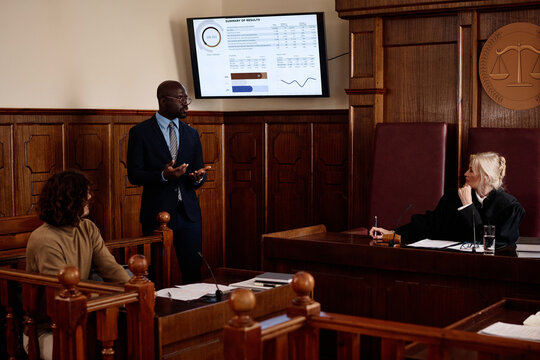Understanding the Art of Trial Presentations: Trick Strategies for Effective Legal Arguments
Understanding the Art of Trial Presentations: Trick Strategies for Effective Legal Arguments
Blog Article
How to Create Involving Test Discussions That Gain Juries and Juries
Crafting engaging test presentations that astound judges and juries is a nuanced art that needs a calculated approach. By employing cutting-edge aesthetic tools, integrating interactive components, and committing time to rigorous method and rehearsal, legal professionals can substantially improve the influence of their courtroom presentations.
Comprehending Your Target Market
To successfully involve your audience throughout trial discussions, it is crucial to recognize their preferences, assumptions, and level of competence in the topic. By customizing your presentation to fulfill the details demands of the target market, you can boost their understanding and retention of the info offered.
Begin by looking into the demographics of the audience, such as age, education and learning degree, and occupation. This information can assist you evaluate their familiarity with legal treatments and change your presentation design appropriately. A jury might need simpler language and more visual help contrasted to a team of lawful professionals.
Moreover, consider the psychological and emotional aspects of your audience. Are they understanding towards particular debates or more inclined towards facts and proof? Recognizing these subtleties can help you frame your presentation in such a way that reverberates with the target market on a deeper degree.
Narration Strategies
Understanding your target market's assumptions and choices can considerably influence the effectiveness of your trial discussions, particularly when executing storytelling strategies to encourage and captivate. Narration is an effective device that can aid attorneys link with courts and juries on a much more psychological degree, making complicated legal arguments extra memorable and relatable.

Integrating vibrant information, individual narratives, and rhetorical gadgets can further boost the narration experience, maintaining the audience involved and invested in the result of the case. By crafting a persuasive story that resonates with the values and feelings of the court and courts, lawyers can boost the chances of winning their debates and accomplishing favorable decisions.
Visual Presentation Tools
Making use of visual presentation devices can significantly improve the influence and performance of trial presentations by offering a visually appealing way to convey complex info to juries and judges. Aesthetic aids such as graphes, representations, computer animations, and charts can assist streamline complex information, making them much more available and easy to understand to the target market. By including visual aspects right into test presentations, attorneys can produce an engaging story that resonates with jurors and leaves an enduring perception.

Incorporating Interactive Elements
Incorporating interactive aspects into trial discussions can improve target market interaction and comprehension, promoting a much more immersive and interactive court room experience. By integrating aspects such as interactive timelines, 3D animations, clickable exhibitions, and virtual fact reconstructions, legal professionals can astound jurors and courts, making complex details extra accessible and remarkable.
Interactive timelines enable a dynamic screen of chronological events, aiding the audience understand the series of essential occurrences in an instance. 3D animations can bring criminal activity scenes or accident reconstructions to life, offering a thorough aesthetic representation that helps in clearing up intricate information. Clickable exhibits enable customers to interact with evidence, papers, or pictures, enabling a hands-on exploration of essential information.
Moreover, virtual fact repairs can move the audience into the heart of the action, providing an engaging point of view that standard presentations may do not have. These interactive components not only involve the visitors yet likewise empower them to proactively get involved in the trial Learn More process, causing a more impactful and persuasive court discussion.
Practice and Practice Session
To successfully utilize the capacity of interactive elements in trial presentations, detailed practice and practice session are necessary to ensure smooth integration and delivery in the courtroom setting. Practice and rehearsal help test presenters come to be knowledgeable about the web content, timing, and flow of their discussions, enabling them to confidently browse through different aspects such as videos, animations, or interactive graphics. By practicing their shipment, presenters can refine their talking abilities, body language, and general presentation style to enhance persuasion and integrity before the court and court.
Throughout practice, presenters can recognize any type of technical concerns that may occur with interactive elements, ensuring that every little thing runs smoothly throughout the actual test. In addition, practicing before a simulated audience or colleagues can supply beneficial responses on the performance of the interactive components and the general discussion. This feedback permits presenters to make necessary changes and enhancements prior to tipping into the court, eventually raising the impact and success of their test discussions.
Conclusion
To conclude, developing appealing test discussions that astound courts and juries calls for a deep understanding of the audience, efficient narration strategies, aesthetic tools, interactive components, and detailed practice (Trial Presentations). By applying these methods, attorneys can effectively share their debates and proof in an engaging manner that resonates with the decision-makers in the courtroom
Using visual presentation tools can greatly enhance the effect and efficiency of test presentations by supplying a visually engaging way to share intricate info to courts and courts. By incorporating aesthetic aspects right into test discussions, legal representatives can develop an engaging narrative that reverberates with jurors and leaves a long-term impression.
One prominent aesthetic discussion tool is the usage of multimedia discussions, which permit for the assimilation of videos, photographs, and audio recordings to supplement spoken debates. Trial Presentations.To successfully leverage the possibility of interactive elements in test presentations, extensive technique and practice session are essential to ensure official source smooth integration and click for more info distribution in the courtroom setup. Technique and practice session assistance test presenters become familiar with the material, timing, and flow of their presentations, permitting them to with confidence navigate via different components such as videos, animations, or interactive graphics
Report this page